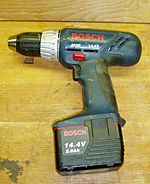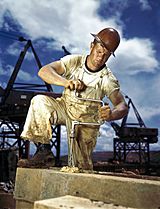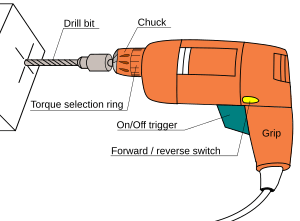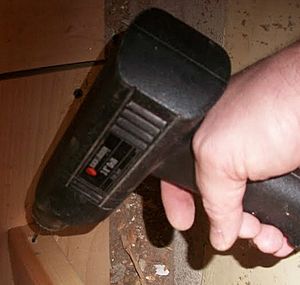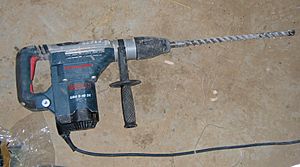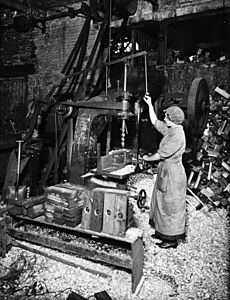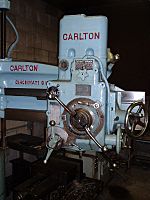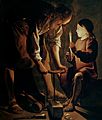Drill facts for kids
A drill is a cool electric tool with a spinning tip. You can use it for many different jobs. It all depends on what you attach to it! If you put a drill bit on it, you can make holes in things like wood or metal. You can also attach a driver bit to put screws into materials. Some drills run on a battery, while others plug into a wall outlet.
Contents
The History of Drills

Imagine way back, about 35,000 years ago! Early humans, called Homo sapiens, figured out that spinning a pointed rock could make a hole. This was the very first idea for a drill!
Later, people used a smooth stick, sometimes with a sharp flint tip. They would rub it between their hands to spin it and make holes. Many old civilizations, like the Mayans, used these "hand drills." The oldest things with holes in them, like bones and shells, are from this time.
About 10,000 years ago, people invented the bow drill. This was the first machine drill! They tied a string around a stick and then attached the string to a bow. This made the stick spin much faster and easier. Bow drills were used to start fires, work with wood and stone, and even for ancient dentistry!
Archaeologists found ancient graves in Pakistan, from about 7,500 to 9,000 years ago, where some people had drilled teeth! In ancient Egypt, pictures show carpenters using bow drills around 2500 BCE. These drills were used all over the world and are still used today for some things.
Around 3000 BC, the ancient Egyptians also created the core drill. Later, during Roman times, the pump drill was invented. This drill used a vertical rod with a heavy spinning wheel to keep it steady and powerful.
In the 1200s, the hollow-borer tip was developed. This was a stick with a metal tube, like copper, on the end. It drilled a hole by only grinding the outer part, which made drilling easier and faster.
For larger holes, people started using the auger sometime between Roman and Medieval times. The auger had a twisting, screw-like bit, much like modern drill bits. The brace and bit was another hand-powered drill. We don't know exactly when it was invented, but the oldest picture of it is from the 1400s. It had a crank handle that you turned to spin the bit.
In China, as early as 221 BC, during the Qin Dynasty, churn drills were invented. These drills were made of wood and needed a lot of effort, but they could drill through solid rock up to 1500 meters deep! Churn drills came to Europe in the 1100s.
Then came the electric motor, which changed everything! In 1889, Arthur James Arnot and William Blanch Brain from Australia patented the first electric drill. In 1895, brothers Wilhelm and Carl Fein from Germany made the first portable electric drill you could hold. Finally, in 1917, Black & Decker patented the modern trigger-switch, pistol-grip drill. This was the start of the drills we use today!
Types of Drills
There are many kinds of drills. Some you power by hand, others use electricity or compressed air. Some even use small engines, like for drilling holes in the earth. Drills that also hammer are great for hard materials like concrete or stone. Huge drilling rigs are used to dig deep holes for water or oil. Some small tools can even be powered by a drill!
Hand Drills
People have used many types of hand-powered drills over hundreds of years. Here are a few:
- Bow drill: Uses a bow to spin the drill.
- Brace and bit: Has a crank handle you turn.
- Gimlet: A small, hand-held tool for making small holes.
- Hand drill (also called "eggbeater" drill): Looks a bit like an eggbeater and you crank a handle to spin it.
- Breast drill: Similar to an "eggbeater" drill, but it has a flat part you lean against your chest for more power.
- Push drill: You push down on the handle, and it spins the bit.
- Pin chuck: A tiny drill used by jewelers.
Pistol-Grip (Corded) Drills
These drills, shaped like a pistol, are the most common type you see today. They come in many different kinds. There are even "right-angle" drills that plumbers and electricians use to drill in tight spots.
In the past, you could buy many attachments to turn a corded drill into other tools, like sanders or saws. This was cheaper than buying a separate tool for each job. Now, it's more common to have cordless tools where one battery works with many different tools.
Hammer Drills
A hammer drill looks like a regular electric drill, but it can also hammer! This hammering action helps it drill into hard materials like concrete or brick. You can turn the hammer action on or off.
The hammering happens because of special plates inside that make the drill bit pulse forward and backward very quickly as it spins. This pulsing is measured in "Blows Per Minute" (BPM), and it can be 10,000 BPM or more! Hammer drills are good for smaller holes in masonry.
There's also a more powerful type called a rotary hammer drill. Instead of plates, it uses a piston to make the bit hammer. This makes it much more efficient and causes less vibration for the user. Rotary hammer drills can drill larger holes and can even be used just for hammering (like chipping concrete) or just for drilling.
Magnetic Drilling Machines
A magnetic drilling machine is a portable drill used for making holes in metal. It has a strong magnet at its base that sticks to the metal workpiece. This means you can take the drill to the metal, instead of having to move heavy metal to a big stationary drill. They are also called "mag drills."
Rotary Hammer Drills
The rotary hammer drill is a powerful tool that combines hammering and spinning. It's designed for very tough materials like concrete or stone. These drills often use special bits that can handle the strong hammering force. Some rotary hammers can only hammer and drill, while others can also chip away concrete without spinning.
Cordless Drills
A cordless drill is an electric drill that runs on rechargeable batteries. These are super popular because you can use them anywhere without needing an outlet! Most cordless drills have a "clutch" that helps you drive screws without damaging them or the material.
For big jobs, workers often have extra battery packs charging. When one battery runs out, they can quickly swap it for a fresh one. Modern batteries can charge very fast, sometimes in just 10-15 minutes!
Older cordless drills used 7.2-volt batteries. Now, 18-volt drills are most common, but you can find even more powerful ones at 24V, 28V, and 36V. This means they can be as strong as some drills that plug into the wall.
The most common battery types are nickel-cadmium (NiCd) and lithium-ion (Li-ion). NiCd batteries are cheaper but don't last as long and lose their charge faster. Lithium-ion batteries are more popular now because they charge quickly, last longer, and are lighter. They can hold a charge for about two years if not used!
Drill Presses
A drill press is a fixed drill that's usually bolted to a workbench or the floor. It's much more stable than a hand-held drill. It has a base, a column, a table, and the drill head. You use a handle to move the drill bit up and down.
Drill presses have several advantages:
- You don't need as much effort to push the drill into the material.
- The table lets you hold your work securely with a vise or clamp.
- The drill bit is always perfectly straight, so you can drill very accurate holes.
- They usually have more powerful motors, so they can use larger drill bits and drill faster.
Most drill presses let you change the speed by moving a belt on different pulleys. Some modern ones have variable-speed motors. Drill presses are also used for other workshop tasks like sanding or polishing by attaching different tools to the chuck.
Geared Head Drill Presses
A geared head drill press is a type of drill press where the power from the motor goes to the drill bit only through gears inside the machine. This makes it very strong and reliable. These drills are used for metalworking, where you need more power and slower speeds.
You use levers on the side to choose different gear ratios, which changes the speed of the drill. These machines are usually very tough and are found in workshops where heavy-duty drilling is needed.
Radial Arm Drill Presses
A radial arm drill press is a very large geared head drill press. Its drill head can move along a long arm that swings out from the main column. This means you can drill holes over a very large area without having to move the heavy piece of material you're working on. It saves a lot of time!
These drills can handle very big workpieces, as the arm can swing out of the way so a crane can place the material on the table. They are often used for drilling large holes, sometimes as big as four inches in solid steel!
Mill Drills
Mill drills are like a lighter version of a milling machine. They combine a drill press with the ability to move the table precisely in X and Y directions, like a milling machine. This makes them space-saving and useful for lighter metalworking jobs.
Drill Accessories
Drills are often used just as motors to power other tools. Here are some common accessories you can attach to a drill:
- Screw-driving tips: For putting screws in or taking them out.
- Water pumps: To pump water.
- Nibblers: For cutting metal sheets.
- Rotary sanding discs: For sanding surfaces.
- Rotary polishing discs: For polishing surfaces.
Images for kids
-
A painting by Georges de La Tour showing Saint Joseph using a drill.
See also
 In Spanish: Taladradora para niños
In Spanish: Taladradora para niños


